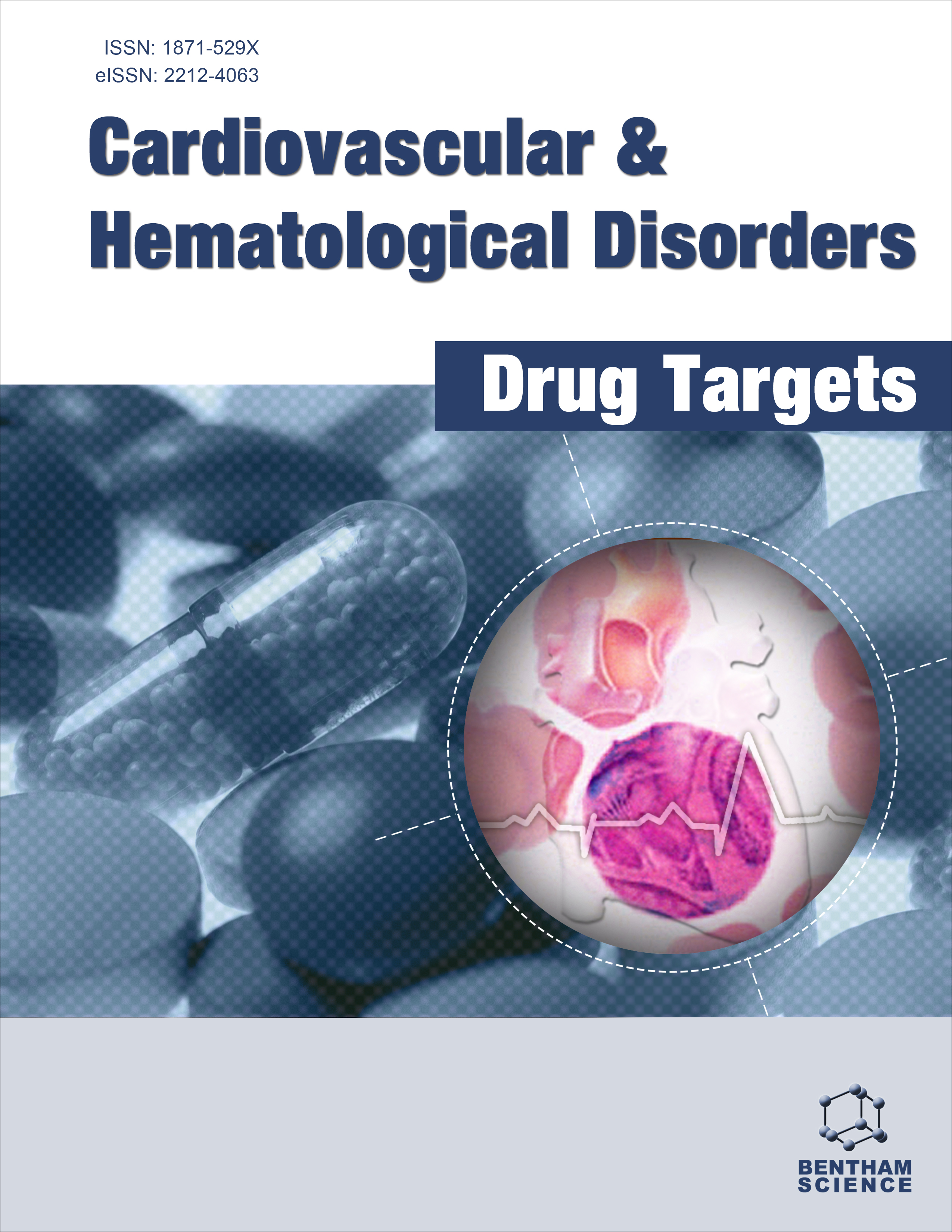- Home
- A-Z Publications
- Cardiovascular & Haematological Disorders - Drug Targets
- Previous Issues
- Volume 18, Issue 1, 2018
Cardiovascular & Haematological Disorders - Drug Targets - Volume 18, Issue 1, 2018
Volume 18, Issue 1, 2018
-
-
Regulation of Smooth Muscle Myosin Light Chain Phosphatase by Multi-site Phosphorylation of the Myosin Targeting Subunit, MYPT1
More LessAuthors: Justin A. MacDonald and Michael P. WalshBackground: Smooth muscle contraction is triggered primarily by activation of Ca2+/calmodulin-dependent myosin light chain kinase leading to phosphorylation of the regulatory light chains of myosin II. Numerous contractile stimuli also induce inhibition of myosin light chain phosphatase thereby prolonging the contractile response. The phosphatase is a trimeric enzyme containing a catalytic subunit, a regulatory, myosin- Read More
-
-
-
Connexin43 and Myocardial Ischemia-Reperfusion Injury
More LessAuthors: Lingyun Zu, Ningxin Wen, Changjie Liu, Mingming Zhao and Lemin ZhengBackground: Recently, the treatment and prevention of ischemic cardiomyopathy is one of the emerging research topics in the cardiovascular field. Gap junction is the basic structure of cardiac electrophysiology. Connexin is the basic unit of gap junctions. Connexin43(CX43) is the most abundant member of Cx family in the heart, the normal expression of Cx43 is important for heart development, electrically coupled cardiomyocyt Read More
-
-
-
Epicardial Adipose Tissue: Another Tassel in the Complex Fabric of Atherosclerosis
More LessAuthors: Nikolaos Alexopoulos and Paolo RaggiAtherosclerosis affects the majority of adult individuals in industrialized nations and it is beginning to affect even traditionally spared populations. The classic view has been that the precipitating events are intraluminal. However, good evidence supports the possibility that at least part of the atherosclerosis burden may be the consequence of extra-luminal noxious stimuli. Additionally, the epidemic of obesity, insulin resistance Read More
-
-
-
Cholesterol Homeostasis and Liver X Receptor (LXR) in Atherosclerosis
More LessAuthors: Shuyuan Guo, Luxiao Li and Huiyong YinCholesterol is an important lipid for maintaining cell membrane fluidity and generation of various hormones and bile acids. Thus, it is critical to maintain cholesterol homeostasis including absorption, trafficking, biosynthesis, and efflux; dysregulation of cholesterol homeostasis may lead to human disorders such as atherosclerosis. As a cholesterol sensor, nuclear receptor liver X receptor (LXR) is an important factor regulati Read More
-
-
-
The Endocannabinoid System and Heart Disease: The Role of Cannabinoid Receptor Type 2
More LessAuthors: Makenzie L. Fulmer and Douglas P. ThewkeDecades of research has provided evidence for the role of the endocannabinoid system in human health and disease. This versatile system, consisting of two receptors (CB1 and CB2), their endogenous ligands (endocannabinoids), and metabolic enzymes has been implicated in a wide variety of disease states, ranging from neurological disorders to cancer. CB2 has gained much interest for its beneficial immunomodulat Read More
-
-
-
Immunomodulatory and Anti-inflammatory Effects of Thymoquinone
More LessBackground: The immunomodulatory properties of Nigella sativa seed, as a basis of its clinical applications by many cultures have been reviewed. Thymoquinone (TQ) is one of the major bioactive components of the volatile oil of N. sativa seeds. Methods: The review on immunomodulatory and anti- inflammatory effects of TQ was focused on published literature in the English language. The literature search was conducted in the Read More
-
-
-
Berberine Encapsulated PLGA-PEG Nanoparticles Modulate PCSK-9 in HepG2 Cells
More LessAuthors: Chinedu C. Ochin and Mahdi GarelnabiBackground: The developments of new parenteral approaches to target PCSK-9 for the treatment of LDL-Cholesterol has yielded impressive results; and have shown significant decreases in the risk of mortality associated with hypercholesterolemia. However improved and convenient alternate approaches that exploit the beneficial drug target properties of PCSK-9 also need to be explored and developed. One such approach is t Read More
-
-
-
Glucose Lowering Activity of Anvillea Radiata Coss & Durieu in Diabetic Rats
More LessAuthors: Morad Hebi and Mohamed EddouksIntroduction: Anvillea radiata Coss. & Durieu (Asteraceae) is an endemic plant from North Africa (Morocco and Algeria). This plant has many traditional uses including treatment of obesity and diabetes. Aim of the Study: The study aims to evaluate the antidiabetic effect of aqueous extract of Anvillea radiata (A. radiata) leaves on both normal and streptozotocin (STZ)-induced diabetic rats treated at a dose of 10 mg/kg body Read More
-
Volumes & issues
-
Volume 24 (2024)
-
Volume 23 (2023)
-
Volume 22 (2022)
-
Volume 21 (2021)
-
Volume 20 (2020)
-
Volume 19 (2019)
-
Volume 18 (2018)
-
Volume 17 (2017)
-
Volume 16 (2016)
-
Volume 15 (2015)
-
Volume 14 (2014)
-
Volume 13 (2013)
-
Volume 12 (2012)
-
Volume 11 (2011)
-
Volume 10 (2010)
-
Volume 9 (2009)
-
Volume 8 (2008)
-
Volume 7 (2007)
-
Volume 6 (2006)
Most Read This Month
Article
content/journals/chddt
Journal
10
5
false
en


